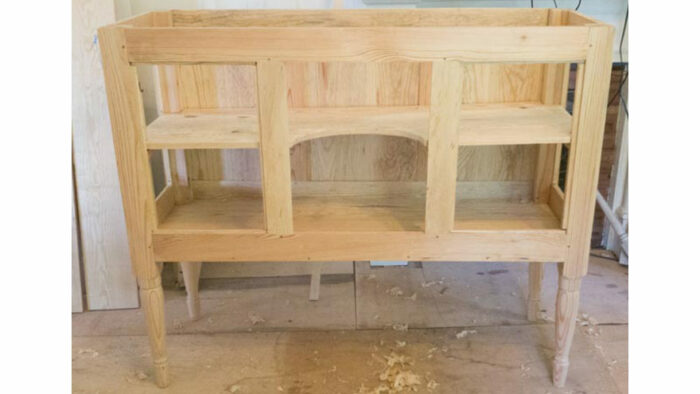Correcting the record
Dr. Tiffany Momon and Jerome Bias describe the creative ways in which enslaved craftspeople made their own reality despite their hardships. This is where their true power lies.
The Spring 2022 conference at the Museum of Early Southern Decorative Arts is over, as is my photo shoot with Anissa Kapsales. It’s hard to believe that well over a month has gone by, but you know what they say about time passing quickly when you’re having fun (or in this case, going through radiation treatment as a means to manage cancer pain). This early-May post should have been published in early April.
So I want to talk about the conference. I attended only about half the presentations, unable to sit still for more than a couple of hours at a stretch because it felt like someone had poured a bag of glass shards into my abdomen. (Apologies for the graphic description.) There was a great variety of perspectives, from a hands-on demonstration of joinery and molding by Peter Hudson of Colonial Williamsburg to a lecture by Alexandra Kirtley, curator at the Philadelphia Museum of Art. But most impressive to me were the presentations that focused on the historical contributions by craftspeople who were enslaved.
It has not escaped my notice that woodworking in America has been overwhelmingly a white persons’ occupation; the absence of Black people in particular has been blinding, both in the field, where I have worked in shops and on job sites for the past four decades, in popular TV programming, and in print. So every time I hear some nugget about how Black people have contributed to the wealth of material culture in this country, whether as furniture makers, builders, or trim carpenters, I want more.
Two speakers at this conference made an especially powerful impression on me. On the scholarly side, Dr. Tiffany Momon, assistant professor at Sewanee College, introduced attendees to the Black Craftspeople Digital Archive, which catalogs the individual Black craftspeople who made so much of the furniture and built so many of the buildings we appreciate today throughout the American South. It’s astonishing, and frankly horrifying, to think that so many of those whose life’s work still stands today have gone unrecognized for so long. Their names, occupations, and more have all been there, in various public and private records, since the 1800s. But until now, no one apparently thought it was important to acknowledge who built and furnished those buildings.
One result has been this grossly inaccurate picture we have had of those who did this work. More damning than our flawed picture is that this skewed sense of history has deprived Black people of the kind of exemplars that white people have had—role models of people like them, working at the highest levels in this field. You may not consider this important, but as someone who got her start in furniture making in 1980, I can tell you that the absence of clearly relatable exemplars in my own life has been a real problem. As a woman of 21 and all the way through my 30s, even 40s, I knew of precious few women furniture makers. I modeled myself in my capacity as a woodworker on men. While elaborating on the arguable advantages and disadvantages of modeling myself on men would require far more space than I have in this post, I can say that for me, the absence of women, and especially women over the age of 40, has been unhelpful, to put it mildly. All of which is to say that the invisibility of Black furniture makers has in its own right insidiously discouraged Black people from getting into woodworking, thereby perpetuating the sense that woodworking is a field occupied by white people and those of Asian descent.

The other presentation that grabbed me—this one, in the most visceral ways—was by craftsman Jerome Bias of Southern Heritage Furniture, who laid out and cut joints for a sideboard based on a Newberry County, S.C., sideboard/food safe while narrating the verbal parts of his presentation; Jerome’s sideboard-in-process is at the head of this post. “It is a furniture form that is only found in the upstate area of South Carolina,” he told me, “in particular in the Dutch Fork area. The original is located at the Lexington County Museum, Lexington, South Carolina.” While laying out and cutting joints, he simultaneously regaled attendees with information about what he was doing with those tools, in addition to sharing stories and reflections on how impoverished an understanding most people today have of what his enslaved forebears really experienced.

When I say “his forebears,” I mean that literally. Jerome comes from a long line of Americans who were enslaved across the South, from Alabama and Kentucky to Maryland. His more recent ancestors have inherited the trauma of that enslavement—and notwithstanding the arguable overuse of that word “trauma” in contemporary American culture, it is appropriate here. “My great-grandfather was enslaved,” he told me. “I am the third generation after slavery. There are over 60 cousins in my generation; more than three-quarters of us have failed marriages that are the direct result of the trauma that was experienced by my ancestors while enslaved.”
But Jerome insists that we not relegate his and others’ enslaved ancestors to the category of miserable unfortunates. Was slavery a crime, based on any adequate notion of human dignity since the Enlightenment? You bet. But rather than focus on the wretchedness, Jerome would have us appreciate the profoundly creative ways in which enslaved people made their own reality, despite their hardships. And this is where his true power lies.
“Enslaved people had feelings and lives,” he told me in a recent interview. “They lived and loved. They were humans in an inhuman situation who crafted a balm.” By balm, he means in part “small points of crafting freedom in their daily lives.” For example, a furniture maker could always take pride in their abilities, just as we do today—”‘I’m a craftsman,’ for example, or ‘I’m an organic gardener’; just as today, seeing a wild violet, they might pick it and take it to their daughter and say ‘I love you.'” Cultivating this awareness that the lives of enslaved people were full, even if making them so took vastly more effort than it might have for white people of wealth who could rely on others to build and mend, serve and clean up, is extremely important. What beauty there is in that effort, even as we wish it had not been necessary. Of all the kinds of creativity we humans are capable of, this searching for, finding, and sharing of grace, this celebration of the most-hard-won, simple pleasures amid truly punishing circumstances must be among the highest in moral terms.

For more, make a point of following Jerome. Although I’m not at liberty to share specifics, he has some exciting projects in the works that are going to blow some minds, in the best ways. Now that Jerome is on my personal radar, I’m looking forward to seeing what this accomplished craftsman, gardener, and cook is going to come up with next.
So thank you, Museum of Early Southern Decorative Arts, for introducing me to these fine speakers and thinkers, along with so much else that was edifying and delightful in your Spring 2022 conference.
–Nancy Hiller, NR Hiller Design
 |
A very good cabinetmaker |
 |
It’s time Thomas Day took his place alongside Townsend, Phyfe, and the others |
 |
Two tea boxes, two trailblazers, and one happy woodworker |













Comments
Thank you for this!
Thank you Nancy for this wonderful article! We all hope you are doing well. I have always wanted to visit the Museum of ESDA, and will put this on my bucket list for the near future. I will also be reading the links to more information about Jerome and his great talents.
Wow, such a great article. I enjoy how Fine Woodworking finally gives voice to a much broader spectrum of craftspeople. I would love to learn more about Black artisans from our past and present in future articles.
Thanks, Nancy. Always enjoy your columns, and this one is especially interesting. Opens up new vistas of great work to be inspired by.
Thank you for raising our awareness and giving us the paths to follow. I will share this with others.
Log in or create an account to post a comment.
Sign up Log in